Menu
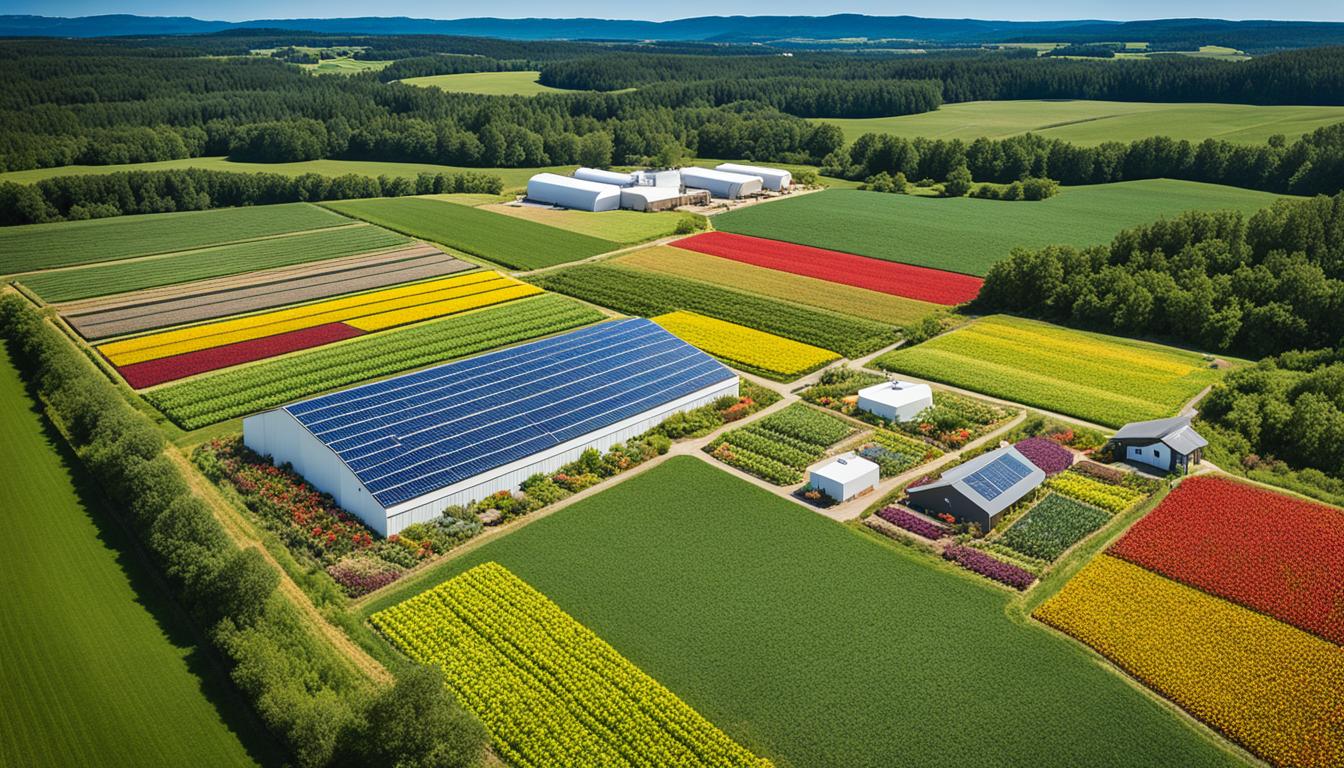
Did you know biodynamic farming started in 1924? It was created to fight problems caused by industrial farming. This method sees farms as complete systems that need balance to thrive. It mixes science with a respect for nature’s deeper connections. The goal is to make the earth more alive and protect our food’s quality.
Biodynamic farming is part of a unique movement focused on sustainable practices. It draws from Rudolf Steiner’s philosophy. This method treats a farm as a single living thing. It shows how everything on the farm, plus the natural world, are all linked. It aims to not only boost farm output but also help the environment and communities.
Rudolf Steiner started biodynamic farming, offering a new way to see agriculture. He connected nature’s forces with farming tasks. This formed the basis for biodynamic farming. It looks at the big picture, linking farm work to cosmic cycles for healthier ecosystems.
Biodynamic farming aims for a well-rounded farm system. It tries to grow at least half of its animal feed onsite, cutting the need for outside resources. An important part is setting aside 10% of the land for wildlife.
Biodynamic farms follow the Demeter standard. Everything they grow, including crops, must meet this standard. It means using special herbal mixes in compost and sprays on plants. These boost growth and fight diseases without harmful chemicals.
To get the most from biodynamic farming, people use special calendars. These tell them the best times for planting and harvesting based on the stars. The method also supports using old-style, non-modified seeds and animal breeds. It’s all about keeping farming practices good for the earth and diverse.
In summary, the principles of biodynamic farming, laid out by Steiner, bring together many strategies. They’re all there to develop a strong and eco-friendly farming system.
The Biodynamic calendar is key in biodynamic farming. It follows the Moon’s phases and sky positions to help farmers. They use it for the best times to plant, grow, and harvest crops.
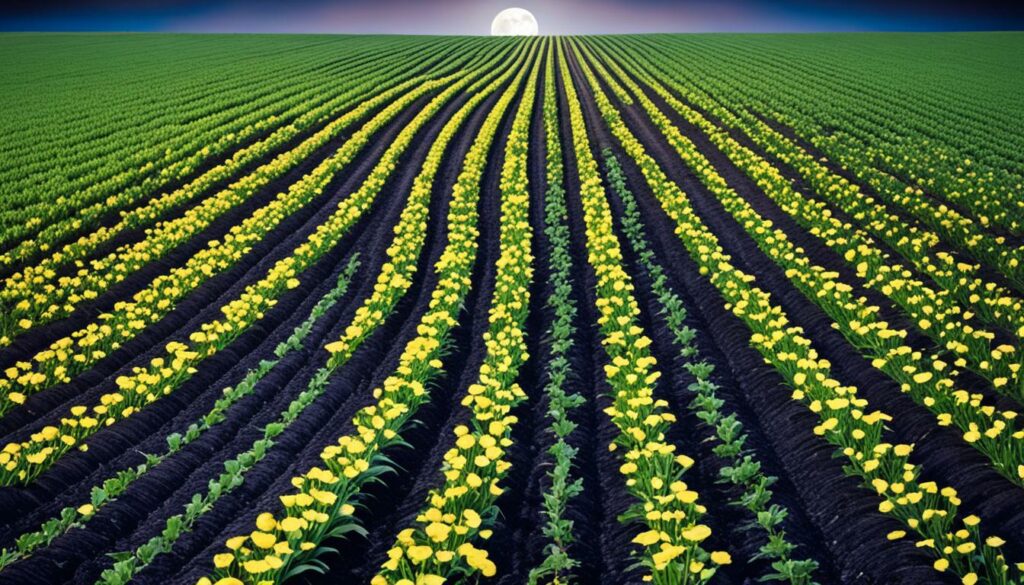
The Biodynamic calendar connects moon phases with plant growth. It says plants grow best when the moon is getting larger. This is good for leaves and flowers. When the moon gets smaller, it’s better for root growth.
Biodynamic farmers plan their work with this. They believe it works with nature’s cycle to make their crops stronger and healthier.
Another important part of the calendar is the moon’s up and down movement. This cycle lasts about 27.2 days. It helps with plant growth and improving the soil.
The moon looks like it’s moving up in the sky during the ‘rising’ period. This time favours growth of parts above the ground. Then, as it looks like it moves down, it’s best for work in the soil.
| Moon Phase | Ideal Activity |
|---|---|
| Waxing Moon | Above-ground growth, sowing seeds |
| Waning Moon | Pruning, root development |
| Ascending Moon | Propagation, leafy crops |
| Descending Moon | Root crops, soil enrichment |
Farmers use this calendar to work closely with nature. They think it helps their crops and the whole farm stay healthy.
Biodynamic farming treats the farm as one big, self-sufficient organism. This method includes many different plants and animals. It uses natural biodynamic preparations to make the farm balanced and healthy. It’s all about creating a harmony that takes care of itself.
Each biodynamic farm acts like its own living thing. It combines plants, animals, and the soil together. Over 5,000 farms, in 60 countries, follow these ideas. They cover huge areas, proving this method works worldwide. These farms keep strict rules like growing most of their animal feed on the farm and leaving 10% of land for wildlife. Following these rules helps the farm thrive as a whole.
Biodynamic farming loves different types of plants and animals. It’s not just about food plants. They also grow flowers, herbs, and even native plants. This mix helps farms deal with pests naturally and keeps the soil healthy.
Special compost is at the heart of biodynamic farming. It uses six special plants to make the soil really healthy. Besides compost, farmers use special liquid sprays that give plants and soil lots of energy. These methods are key to keeping the farm lively and strong.
Biodynamic farming has many pluses. It’s great for making the land and the crops healthy. It also helps the environment in big ways. This farming method cares for the soil and helps many different plants and animals thrive. Thus, it finds a balance in nature.
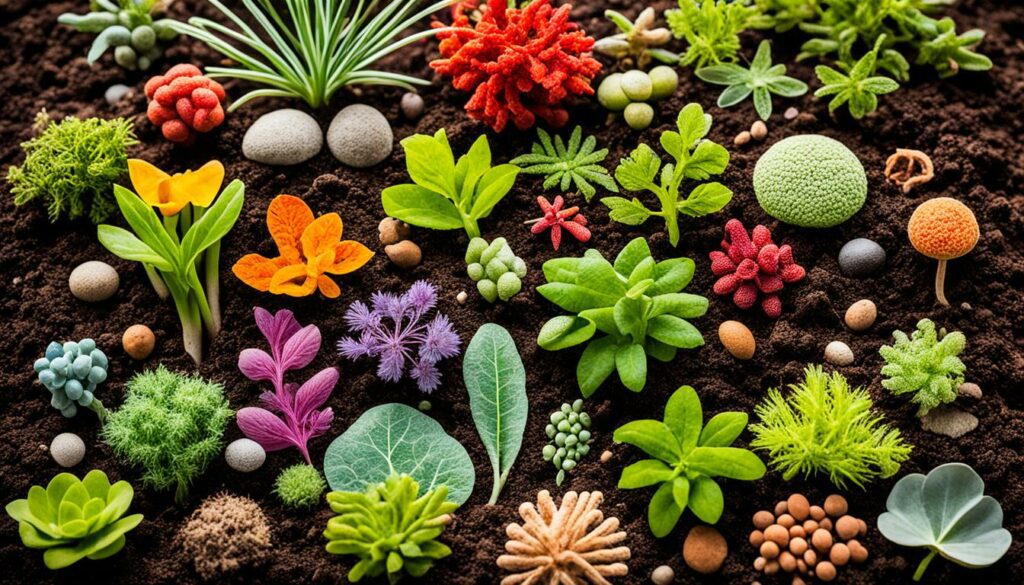
Biodynamic farming puts a lot of effort into making the soil better. It uses special natural mixes to feed the soil. For example, mixes with yarrow and nettle. These materials add important nutrients and life to the soil. This makes the plants grow stronger and gives better crops.
This way of farming also encourages lots of different living things. It doesn’t just grow one type of plant. Instead, it mixes in many plants and animals. This mix helps keep the land healthy and safe from pests. It makes the farm able to handle changes better, like the weather getting warmer or colder.
One big goal of biodynamic farming is to do everything it needs by itself. It makes its own food and fertilisers which means it doesn’t rely on stuff from outside. This cuts down costs and is good for the environment. Also, it makes the farm worth more and the farmers happier. It’s like a circle of good things happening because the farm can take care of itself.
Biodynamic farming has significant benefits for the environment and the economy. But, it comes with unique challenges. The main one is the large investment of time and knowledge needed. This is to understand the detailed biodynamic methods.
To use biodynamic methods, farmers must learn deeply about farming. They need to know both usual farming ways and biodynamic principles. Learning these includes working with the moon’s cycles and making special composts. Newcomers might find it hard to understand and use these methods due to the time and effort needed.
Biodynamic farming is complex. It treats every farm as a unique, living thing. It mixes soil, forests, and meadows into a system that looks after itself. Everything must stay inside the farm, like using livestock manure to make compost. This keeps the nutrients flowing and makes the farm healthier.
Farmers see weeds, pests, and diseases differently in biodynamic farming. They think of them as signs that something is not right. So, they change the way the farm is managed. They try to make plants and animals suit their environment better. They also save seeds and work to improve the farm animals’ genes. This makes their farm ready to fight off problems on its own. Overcoming these challenges makes their farming strong, but it takes a lot of learning and effort.
“The energy flow in a biodynamic farm from sun, stars, rain, wind, and the farm itself results in a healthy farm that exudes abundance and life-giving potential when in a balanced state. However, achieving this balance involves dedicated commitment, understanding of cosmic rhythms, and meticulous farm management,” – Biodynamic Association.
In summary, biodynamic farming is well-rewarded, even though it’s hard work to start. The way farmers harmonise every part of their farm is what leads to success. It shows how important careful and complete farming is.
Organic and biodynamic farming both follow sustainable agriculture principles. However, biodynamic farming includes spiritual and cosmic concepts. These additional elements make it unique.
Organic farms avoid synthetic inputs. On the other hand, biodynamic farms see the entire farm as a holistic system. They use spiritual and cosmic ideas to improve the farm’s health.
Biodynamic methods use specific preparations and plant based on lunar and planetary cycles. They strive to remove synthetic inputs completely. This approach makes their farming style more integrated.
Biodynamic farming typically shows more sustainability benefits than organic farming. For example, they reserve 10% of land for wild areas. This practice helps to increase biodiversity.
Biodynamic farms also retain 40% more water than conventional ones. This improves the environment’s ability to handle stress.
Demeter USA has set rigorous standards for biodynamic farms. These include soil health, climate mitigation, and food security. Their certifications guarantee high sustainability levels.
In wine production, both organic and biodynamic methods have strict rules. Organic wines in the EU must have low sulphites. The USDA allows only 5% non-agricultural ingredients in organic wines. Biodynamic wines must meet the Demeter standard, ensuring adherence to biodynamic principles.
Biodynamic farming stands out with its use of livestock to improve soil health. Livestock helps in-house fertility and sustains the soil. This practice is vital for real sustainable agriculture.
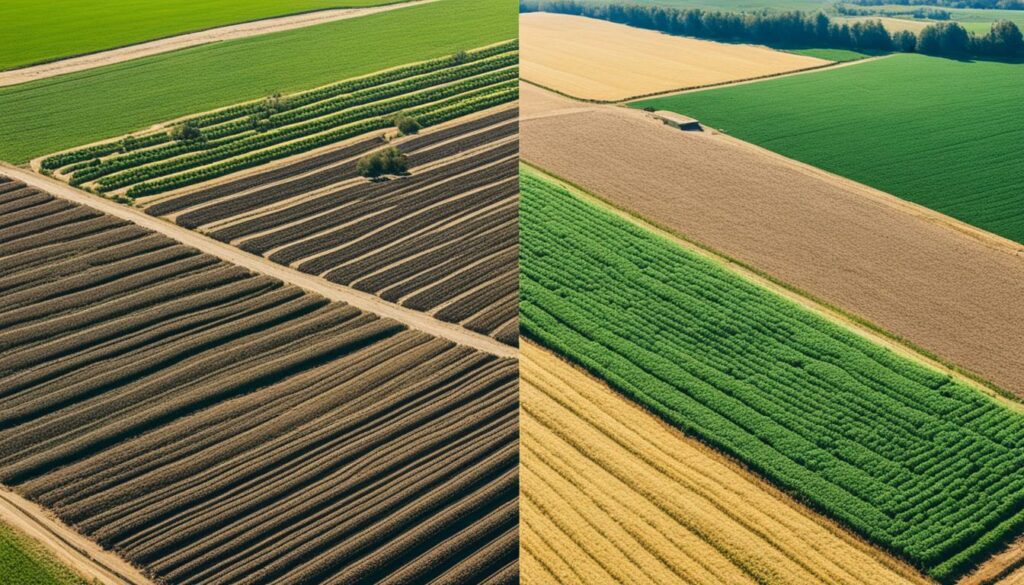
| Aspect | Organic Farming | Biodynamic Farming |
|---|---|---|
| Elimination of Synthetic Inputs | Yes | Yes, with additional spiritual and cosmic considerations |
| Water Retention | Standard | 40% Higher |
| Biodiversity | Encouraged | 10% of land dedicated to wild areas |
| Wine Production | Strict sulphite limits | Demeter standard compliance |
| Certification Requirements | Varies by region | Strict, regulated by the Demeter Association, Inc. |
In our chat about ways to farm sustainably, understanding biodynamic and regenerative farming is key. Both types aim to boost soil health and nature’s variety. Yet, they go about it in very different ways.
Biodynamic farming follows the ideas of Dr. Rudolf Steiner. He came up with this in the 1920s. It looks at a farm as a whole system, focusing on things like using special preparations and planting at certain times with the stars.
Regenerative farming, however, is more about finding what works for each farm. It suggests methods like not tilling the soil much and using cover crops to help the soil. There’s no need to stick to any cosmic schedule. This way is all about letting nature heal itself.
Despite their different ways, both types aim for a few of the same things. They really care about the soil, working hard to make it more fertile. This helps farms produce better and be stronger. They also think a lot about having lots of different plants and animals around, to make the farm a healthy place.
| Aspect | Biodynamic Farming | Regenerative Farming |
|---|---|---|
| Foundational Principles | Steiner’s biodynamic methods | Natural soil regeneration processes |
| Key Practices | Cosmic calendar, biodynamic preparations | No tillage, cover cropping |
| Biodiversity Focus | Minimum 10% biodiversity reserves | Flexible integration of biodiversity |
| Consumer Trend | 20% more for local quality products | Support small producers |
In the journey towards sustainability, we come across two key methods: biodynamic farming and permaculture. Each has its own way of working with nature. But they share the goal of making farming kinder to the earth. Both have a lot to offer, and by looking closely, we can learn from their differences.
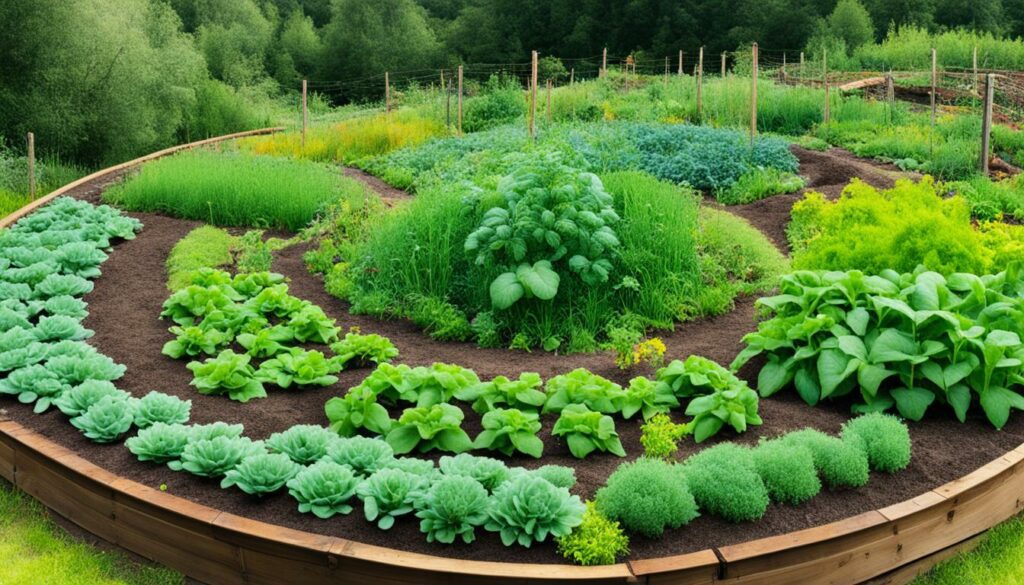
Biodynamic farming views a farm as a single, living system. This idea came from Rudolf Steiner, who believed in a holistic approach. It includes care for the land and the use of certain spiritual and cosmic practices. Foods labelled ‘Biodynamic’ or ‘Demeter’ show this method in action.
Permaculture, on the other hand, looks at the bigger picture. It was developed by Bill Mollison and David Holmgren. This approach applies to farming, but also to how we live. It uses careful planning at the start to lessen ongoing work. Permaculture’s key aim is ethical and sustainable treatment of the planet.
Even though biodynamic farming and permaculture work in different ways, they share main goals. They both aim to offer a sustainable, earth-friendly future. Biodynamics brings in mystical views alongside farming. Permaculture, however, mainly sticks to proven scientific fact.
Support for both approaches is strong globally. They both offer methods to make farming last long, while also being eco-sensitive. Biodynamic practices mix spiritual beliefs with practical farming. Meanwhile, permaculture looks at scientific principles for its designs. The two together aim to make farming more robust and green, attracting those who care deeply about the planet.
| Aspect | Biodynamic Farming | Permaculture |
|---|---|---|
| Originators | Rudolf Steiner | Bill Mollison and David Holmgren |
| Focus | Agricultural Practices | Ecological and Social Systems |
| Philosophy | Spiritual-Ethical-Ecological | Ecological Sciences |
| Educational Requirement | None | Permaculture Design Course (PDC) |
| Community Involvement | Structured Certifications (Biodynamic/Demeter) | Global Network of Practitioners |
| Application | Farming Systems | Broader Living Patterns |
Biodynamic farming sees soil as alive and ever-changing. It needs special care to stay healthy. One key step is boosting *organic matter* through great compost and natural preparations. This makes the soil stronger and more fertile.
Across over 60 countries, more than 5,000 biodynamic farms cover about 400,000 acres. These farms follow strict rules to keep their soil well. They add six herbal mixtures to their compost to help. These mixtures come from plants like yarrow, chamomile, and stinging nettle. They improve soil health by enriching it with good bacteria. This, in turn, stabilises nitrogen and boosts the variety of small life forms living in the soil.
Biodynamic farms aim to feed their animals with half their own-grown food. This keeps the farm’s ecosystem contained and healthy.They also reserve 10% of their land for wildlife, as required by the Demeter Biodynamic Farm Standard. Another important supplement, horn silica, helps plants fight off disease and grow stronger. All these efforts keep the soil in great shape.
Farms also switch the crops they grow in a set pattern. This helps the soil store more carbon, which is great for our planet. Soils full of *organic matter* and humus act as natural CO2 filters. They really help reduce the harmful effects of climate change.
The Demeter Biodynamic® Standard has guided farms worldwide since 1928. This standard helps farms work with nature’s cycles. By following these cycles, farmers can pick the best times for planting and tending their crops. This keeps the soil lively and productive.
Biodynamic farms make sure they give back more to the land than they take. This keeps the soil full of life and ready to grow amazing food. Their all-round method results in a *living soil* that’s full of *organic matter*. This supports a flourishing environment for all living things.
Biodynamic farming is key to boosting diversity and building strong ecosystems. It mixes many plant and animal types to manage pests and keep the farm’s life varied.
Diverse farms are vital for biodynamic success. Demeter Biodynamic Standards are followed by over 5,000 farms across 400,000 acres. It’s a big rule that at least 10% of a farm is set aside to boost plant and animal life. This makes the whole farm more able to cope with changes.
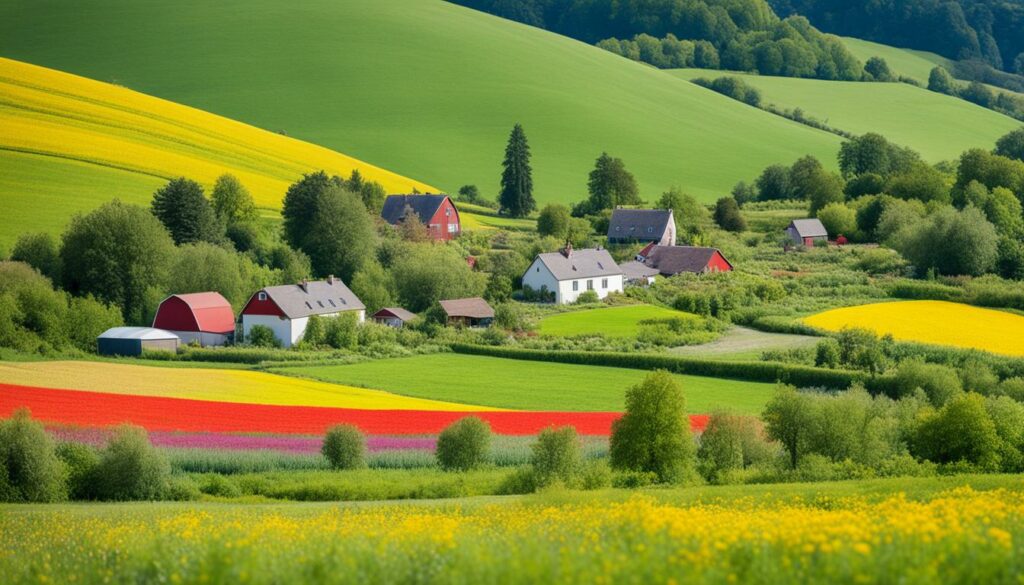
Biodynamic farming tries not to rely on outside fertilizers. It grows most of its animal food and uses special composts for the soil. These composts are made with herbs and plants. They use special sprays too, to protect plants from diseases and help them grow better.
It fits into a larger idea of doing farming that’s good for nature and people. By following special farming schedules that consider the earth and sky’s natural cycles, everything works better. This also helps make plants, animals, and people healthier, and the community and environment stronger.
In the end, by using diverse farming methods, biodynamic agriculture fights the big problem of losing plant and animal types worldwide. It shows there’s a way to farm that helps nature, not hurts it, ensuring a long future for healthy farming.
Holistic agricultural practices in biodynamic farming look at the entire farm and its connection to the environment. They focus on more than traditional methods, looking at the spiritual side of farming as well as the science. The Demeter Biodynamic® Standard, created in 1928, guides these sustainable farming methods.
There are over 5,000 biodynamic farms worldwide, covering more than 400,000 acres across 60 countries. These farms show a big commitment to being green. To follow biodynamic principles, at least half of the food for animals must be grown on the farm. Also, 10% of the land must be set aside for wildlife. This approach aims for a farm that works as a connected and self-sustained system.
To boost soil and plant health, biodynamic farms use special mixtures on plants. Liquid sprays made from horn manure, horn silica, and horsetail tea are common. They also make compost using a mix of plants and minerals. This includes yarrow, chamomile, nettle, oak, dandelion, and valerian. These preparations are known for helping the soil thrive.
Biodynamic farmers follow special calendars when planting and harvesting crops. They use the natural movements of the stars and planets to guide their work. This way of farming shows a deep understanding and respect for the earth and its cycles. It helps ensure farming can be sustainable in different places and climates.
Biodynamic farming is always improving with farmers and researchers working together. Organizations like Demeter International and Demeter USA help set high standards. These standards intend to support a farming system that’s fair and sustainable. They aim to treat the land as a living, interconnected community.
We’re looking at how biodynamic farming helps farms thrive. We look at some great examples that use sustainable and regenerative methods. These case studies show how these ideas work in different places and situations.
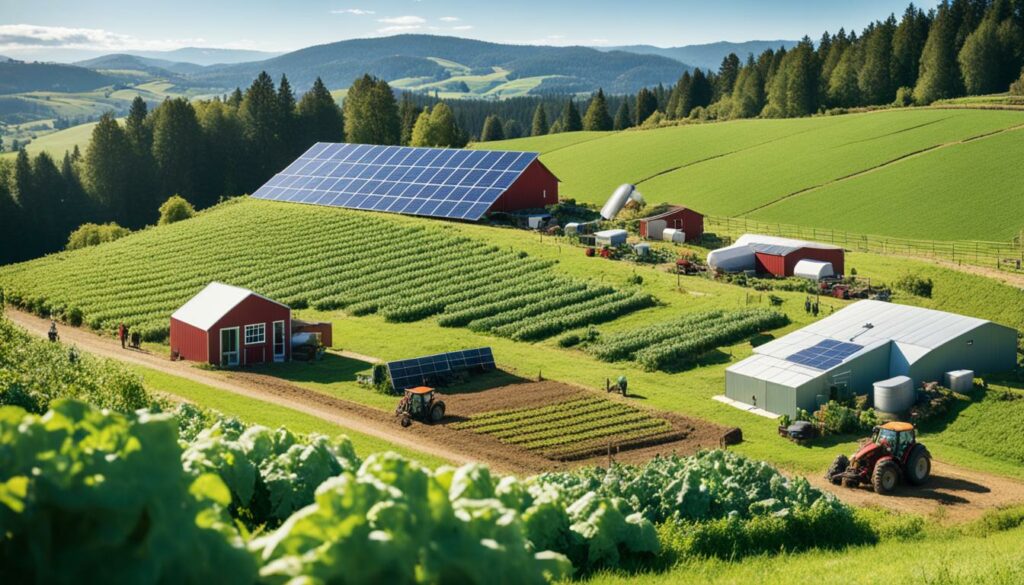
Yatesbury House Farm is the UK’s biggest biodynamic farm. It uses big fields to show that sustainable farming can be large scale. By using crop rotations and working with the moon phases, it keeps the land fertile. This leads to healthier crops, showing how to farm in harmony with nature.
Plaw Hatch Farm mixes biodynamic and organic farming on 500 acres in East Sussex. Since starting in 1994, it has grown a lot, reaching over £1.2 million yearly and hiring 30 people. The farm sells organic meat and eggs. It manages everything from farming to selling, giving customers top quality. Many locals help on the farm or belong to its co-op, building strong community ties.
Loves Lane Farm is a small, biodynamic farm in the countryside. It shows that smaller farms can still achieve a lot with the right methods. By focusing on using less and working with nature, it has become a model of regenerative farming. This approach creates an ecosystem that supports itself.
Overall, the case studies highlight how biodynamic farming leads to success. They prove that regenerative farming can work in many settings, offering hope and ideas for the future of farming.
Biodynamic farming is a detailed method for sustainable agriculture. It uses special biodynamic techniques to improve the soil. Gardens, farms, and more around the planet follow these methods. They aim to create healthy ecosystems where all parts work together.
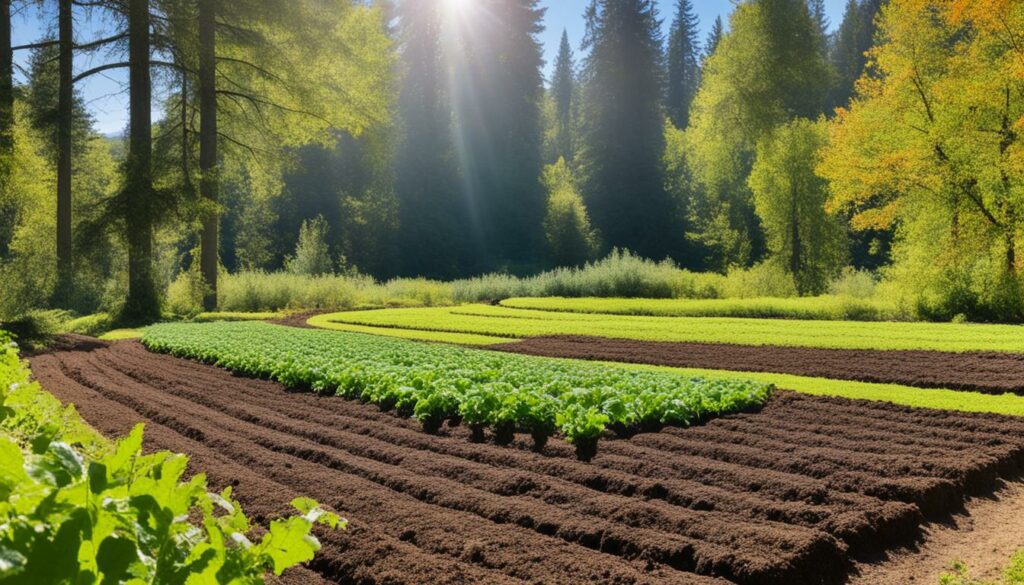
The Demeter Biodynamic Farm Standard lays out important rules to follow. It says at least half of the food for animals must come from the farm. Also, 10% of the land should be for nature. This helps keep the soil productive by supporting a range of life.
One key aspect is using special preparations on the soil and plants. For example, biodynamic farmers use horn manure and silica, plus horsetail tea. These help the plants grow strong and fight off disease. Having animals on the farm also plays a part. They help make the whole system healthier and more balanced.
Farmers must regularly use these preparations and look after the animals well. This mixes caring for the Earth with effective farming. They also plant, move, and harvest crops following a special calendar. It’s based on the moon and stars. This shows the careful planning and balance that is at the heart of this farming.
Thanks to these ecological farming ways, farms everywhere are adopting these practices. They cover more than 400,000 acres in 60 countries. This approach cares for the land for the future, not just for today. It promises a lasting and healthy way forward for farming.
Biodynamic agriculture has a bright future, especially with climate change and new farming methods. A recent conference with over 250 experts talked about this. They showed how ready the industry is to face climate changes and new trends, making it a forward-thinking group.
One main point at the conference was how biodynamic farming can change with the climate. They said it’s important to teach others, build communities, and work with native groups to have greener farming methods. They also talked about using clean energy and new farming ways as key steps. The aim is to care for the land through local efforts and better water and earth management.
Biodynamic farming needs to move with the times for future success. They talked about tracking soil health, connecting with local lands, and bringing young people into farming. Meeting market demands and working with green methods are seen as very important. They said getting the word out more about biodynamic farming will grow the movement.
Participants highlighted the integration of holistic practices, exploring opportunities for media, and global outreach as critical factors for future success.
They also discussed adding holistic medicine and hosting national biodynamic events. In Europe, the biodynamic market is growing fast with lots of products and farms. In the USA, big names like Amy’s Kitchen and Whole Foods are supporting it, showing its wider acceptance.
Biodynamic agriculture has seen a big growth since 1924 thanks to Rudolf Steiner. It’s a sustainable farming approach with strict standards by Demeter. The approach is different from traditional organics but is all about making farms and creatures healthier together.
People worldwide are getting more interested in biodynamic farming. It’s used in many places across Europe, the United States, Australia, and New Zealand. This method works well not only for making wine but also for growing other crops. It focuses on creating high-quality food and healthier soil, fitting with our need for sustainable farming today.
Looking ahead, biodynamic farming’s future looks bright. It faces some challenges like needing a lot of time and knowledge. But the benefits, such as farms becoming self-sufficient and more nature thriving, show its worth. In the end, biodynamic agriculture aims for an agriculture world that’s interconnected and in harmony, giving us hope for the future of farming.
Biodynamic farming treats farms like whole ecosystems. It aims for harmony and is big on sustainability. This method was created in 1924 by Rudolf Steiner. It combines science with a spiritual view of nature. The goal is to make the Earth and our food better.
Biodynamic and organic farming both avoid chemicals. But biodynamic farming adds spiritual and cosmic elements. It uses special preparations and times planting by the moon. This is not found in regular organic methods.
Biodynamic farming sees the farm as a living thing. It focuses on many plants and animals, composting, and mixing crops and animals. This creates a balanced and healthy place.
The biodynamic calendar links farming to the moon and stars. It says the phases and signs affect plants and soil. Farmers believe following this calendar helps their crops and land.
This method boosts soil, increases life variety, and helps the farm take care of itself. By using natural methods and making compost, the soil’s health and fertility grow. This leads to a strong farm environment.
Biodynamic farming is not simple and takes a lot of time. It needs deep knowledge and hard work to do well, including using the special calendar and preparations.
It treats soil as a living thing and feeds it natural matter. By composting and using special preparations, the soil thrives. This way, farming can keep going for years in a good way.
Biodynamic farming wants many plants and animals. This makes a farm strong and able to deal with problems on its own. It also makes sure the farm can last for a long time.
Yes, it’s good at dealing with changing climates. It always finds new ways to be better and last longer. This makes it ready for the future of farming despite hardships.
Both care about soil and life variety. But biodynamic farming adds special methods and follows the stars and moon for planting. Regenerative farming is more open to trying different ways to do better.
It balances all parts of the farm, treating it as one living thing. It’s about farming that is good for the environment and the spirit. This way, the farm works well and fits in nature.
Yes, farms like Yatesbury House in the UK, and Plaw Hatch and Loves Lane are good examples. They show how well biodynamic farming can work in different places.